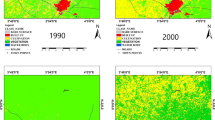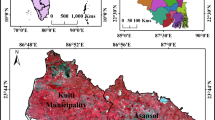Abstract
The study's primary objective is to measure the rate and pattern of land use and land cover changes in Dimapur city, as well as their impact on land surface temperature (LST). Landsat TM (Thematic mapper) data from 2000 and 2007, as well as Landsat OLI (Operational land imager) and TIR (Thermal infrared sensor) data from 2020, were used in the study. In order to examine the city's population patterns, the study was supplemented using LandScan global gridded data for the pre-defined years (1KM × 1KM). The urban sprawl index (USI) was employed to detect urban sprawl in Dimapur, while the urban thermal field variant index (UTFVI) was utilized to investigate surface urban heat islands. Dimapur's built environment grew from 14.74 percent to 39.36 percent between 2000 and 2020, while green spaces shrank from 33.21 percent to 19.44 percent. Between 2000 and 2007, the USI value increased from 0.0037 to 0.0055, indicating substantial urban sprawl in recent years. Between 2000 and 2020, these changes resulted in an increase in mean LST of 17.27 °C (winter) and 26.86 °C (summer) to 19.01 °C (winter) and 31.43 °C (summer). According to UTFVI, the number of locations classified as ecologically bad or worse in Dimapur has increased in recent years. The larger positive correlation between population and built-up areas and LST, as well as the stronger negative correlation between vegetation and population and LST, support the impact of population-induced land use and land cover change on LST development in Dimapur urban area.







Similar content being viewed by others
Data availability
The author of this manuscript declares that there is no associated data with the manuscript.
References
Ajinkya D, Dhruvi P, Drashti P, Jalpa J, Khushali D (2015a) Change in the land use pattern and water bodies of Vadodara City, India with respect to recurring severe floods. J Environ Res Dev 10(1):175
Argueso D, Evans J, Fita L, Bormann K (2013) Temperature response to future urbanization and climate change. Clim Dyn. https://doi.org/10.1007/s00382-013-1789-6
Carlson TN, Ripley DA (1997) On the relation between NDVI, fractional vegetation cover, and leaf area index. Remote Sens Environ 62:241–252
Carneiro E, Lopes W, Espindola G (2021) Linking urban sprawl and surface urban heat Island in the Teresina-Timon conurbation area in Brazil. Land 10:516. https://doi.org/10.3390/land10050516
Chadchan J, Shankar R (2012) An analysis of urban growth trends in the post-economic reforms period in India. Int J Sustain Built Environ 1:36–49
Chakraborty T, Sarangi C, Tripathi SN (2017) Understanding diurnality and inter seasonality of a sub-tropical urban heat island. Bound-Layer Meteorol 163(2):287–309
Chatterjee U, Majumdar S (2022) Impact of land use change and rapid urbanization on urban heat island in Kolkata city: a remote sensing based perspective. J Urban Manag 11:59–71. https://doi.org/10.1016/j.jum.2021.09.002
Chetia S, Saikia A, Basumatary M, Sahariah D (2020) When the heat is on: urbanization and land surface temperature in Guwahati, India. Acta Geophys 68:891–901. https://doi.org/10.1007/s11600-020-00422-3
Dutta D, Rahman A, Paul SK, Kundu A (2021) Impervious surface growth and its inter-relationship with vegetation cover and land surface temperature in peri-urban areas of Delhi. Urban Clim 37:100799. https://doi.org/10.1016/j.uclim.2021.100799
ESSAP, 1993 Economic and Social Survey of Asia and the Pacific. https://www.unescap.org/499 (Accessed on 6 March 2020)
Gohain KJ, Mohammad P, Goswami A (2020) Assessing the impact of land use land cover changes on land surface temperature over Pune city, India. Quatern Int. https://doi.org/10.1016/j.quaint.2020.04.052
Guha S, Govil H, Dey A, Gill N (2018) Analytical study of land surface temperature with NDVI and NDBI using Landsat 8 OLI/TIRS data in Florence and Naples city, Italy. Eur J Remote Sens 51(1):667–678
Guha S, Govil H, Mukherjee S (2017) Dynamic analysis and ecological evaluation of urban heat islands in Raipur city. J Appl Remote Sens 11(03):1. https://doi.org/10.1117/1.JRS.11.036020
Hossain MS, Arshad M, Qian L, Kächele H, Khan I, Islam MDI, Mahboob MG (2020) Climate change impacts on farmland value in Bangladesh. Ecol Indic 112:106181. https://doi.org/10.1016/j.ecolind.2020.106181
Hosseini A, Ahmad P, Musa P (2016) Assessment of institutions in sustainable urban-management effects on sustainable development of tehran: learning from a developing country. J Urban Plan Dev 142(2):05015009
Hua AK, Ping OW (2018) The influence of land-use/land-cover changes on land surface temperature: a case study of Kuala Lumpur metropolitan city. Eur J Remote Sens. https://doi.org/10.1080/22797254.2018.1542976
Imran HM, Kala J, Ng A, Muthukumaran S (2019) Effectiveness of vegetated patches as Green Infrastructure in mitigating Urban Heat Island effects during a heatwave event in the City of Melbourne. Weather Clim Extrem 25:100217
Imran HM, Kala J, Ng A, Muthukumaran S (2019) Impacts of future urban expansion on urban heat island effects during heatwave events in the city of Melbourne in Southeast Australia. Q J R Meteorol Soc. https://doi.org/10.1002/qj.3580
Jaber SM (2018) Landsat-based vegetation abundance and surface temperature for surface urban heat Island studies: The Tale of Greater Amman Municipality. Ann GIS 24(3):195–208
Jacobs S, Gallant A, Tapper N, Li D (2018) Use of cool roofs and vegetation to mitigate urban heat and improve human thermal stress in Melbourne, Australia. J Appl Meteorol Climatol 57:1747–1764. https://doi.org/10.1175/JAMC-D-17-0243.1
John J, Bindu G, Srimuruganandam B, Wadhwa A, Rajan P (2020) Land use/land cover and land surface temperature analysis in Wayanad district, India, using satellite imagery. Ann GIS. https://doi.org/10.1080/19475683.2020.1733662
Kruse PW, McGlauchlin LD, McQuistan RB (1962) Elements of infrared technology: generation transmission and detection. Wiley, New York, NY, USA, p 1962
Kumar A, Agarwal V, Pal L, Chandniha SK, Mishra V (2021) The effect of land surface temperature on urban heat Island in Varanasi city, India. Multidiscip Sci J 4:420–429. https://doi.org/10.3390/j4030032
Liu L, Zhang Y (2011) Urban heat island analysis using the landsat TM data and ASTER data:a case study in Hong Kong. Remote Sens 3(7):1535–1552
Mandal J, Ghosh N, Mukhopadhyay A (2019) Urban growth dynamics and changing land-use land-cover of megacity Kolkata and its environs. J Indian Soc Remote Sens 47:1707–1725
Naikoo MW, Rihan M, Ishitaque M, Shahfahad (2020) Analyses of land use land cover (LULC) change and built-up expansion in the suburb of a metropolitan city: Spatio-temporal analysis of Delhi NCR using landsat datasets. J Urban Manag 9(3):347–359
Neinavaz E, Darvishzadeh R, Skidmore AK, Abdullah H (2019) Integration of landsat-8 thermal and visible-short wave infrared data for improving prediction accuracy of forest leaf area index. Remote Sens. https://doi.org/10.3390/rs11040390
Neog R (2022) Evaluation of temporal dynamics of land use and land surface temperature (LST) in Agartala city of India. Environ Dev Sustain 24:3419–3438. https://doi.org/10.1007/s10668-021-01572-0
Neog R (2021) Analyzing dynamic behavior of land use and land surface temperature in the city of Imphal, India. Acta Geophys 69:2275–2290. https://doi.org/10.1007/s11600-021-00659-6
Oke TR (1976) The distinction between canopy and boundary-layer urban heat Islands. Atmosphere 14(4):268–277. https://doi.org/10.1080/00046973.1976.9648422
Pawe CK, Saikia A (2018) Unplanned urban growth: land use/land cover change in the Guwahati Metropolitan Area. India Geografisk Tidsskrift-Danish J Geogr 118(1):88–100
Ramachandra TV, Aithal BH, Sanna D (2012) Land surface temperature analysis in an urbanizing landscape through multi-resolution data. J Spec Sci Technol 1:1–10
Ritse V, Basumatary H, Kulnu AS, Dutta G, Phukan MM, Hazarika N (2020) Monitoring land use land cover changes in the Eastern Himalayan landscape of Nagaland, Northeast India. Environ Monit Assess 192:711. https://doi.org/10.1007/s10661-020-08674-8
Rizwan AM, Dennis LYC, Liu C (2008) A review on the generation, determination and mitigation of Urban Heat Island. J Ecol Environ Sci 20:120–128
Rousta I, Sarif Md, Gupta R, Olafsson H, Ranagalage M, Murayama Y, Zhang H, Mushore TD (2018) Spatiotemporal analysis of land use/land cover and its effects on surface urban heat Island using landsat data: a case study of metropolitan city Tehran (1988–2018). Sustainability 10(12):4433
Rupanarayan and Verma P, (2018) Assessment of relationship between vegetation and land surface temperature of selected Tehsil in Dist-Raipur, Chhattisgarh, India using GIS & remote sensing technique. Int J Sci Res. https://doi.org/10.21275/SR20524183558
Sarkar R (2019) Urbanization in India before and after the economic reforms: what does the Census data reveal? J Asian Afr Stud 54(8):1213–1226
Sekertekin A, Bonafoni S (2020) Land surface temperature retrieval from landsat 5, 7, and 8 over rural areas: assessment of different retrieval algorithms and emissivity models and toolbox implementation. Remote Sens 12(2):294. https://doi.org/10.3390/rs12020294
Siddique AM, Dongyun L, Li P, Rasool U, Ullah Khan T, Javaid AFT, Wang L, Fan B, Rasool MA (2020) Assessment and simulation of land use and land cover change impacts on the land surface temperature of Chaoyang District in Beijing, China. Peerj 8:e9115. https://doi.org/10.7717/peerj.9115
Sobrino JA, Jimenez-Muoz JC, Soria G, Romaguera M, Guanter L, Moreno J, Plaza A, Martinez P (2008) Land surface emissivity retrieval from different VNIR and TIR sensors. IEEE Trans Geosci Remote Sens 46:316–327
Sobrino JA, Munoz JC, Paolini L (2004) Land surface temperature retrieval from Landsat TM5. Remote Sens Environ 9:434–440
Sobrino JA, Raissouni N, Li ZL (2001) A comparative study of land surface emissivity retrieval from NOAA data. Remote Sens Environ 75(2):256–266
Van De Griend AA, Owe M (1993) On the Relationship between thermal emissivity and the normalized difference vegetation index for natural surfaces. Int J Remote Sens 14:1119–1131. https://doi.org/10.1080/01431169308904400
Wang SLL (2012) Chapter 8—Land-surface temperature and thermal infrared emissivity. In: Wang SLL (ed.) Advanced remote sensing. Academic Press: Boston, FL, USA, pp 235–271
Weng Q, Lu D, Schubring J (2004) Estimation of land surface temperature-vegetation abundance relationship for urban heat island studies. Remote Sens Environ 89(4):467–483
Zhang Y (2006) Land surface temperature retrieval from CBERS-02 IRMSS thermal infrared data and its applications in quantitative analysis of urban heat island effect. J Remote Sens 10:789–797
Zhou J, Chen Y, Zhang X, Zhan W (2013) Modeling the diurnal variations of urban heat islands with multi-source satellite data. Int J Remote Sens 34:7568–7588
Acknowledgements
The author of this manuscript is very much thankful to the earthexplorer.usgs.gov and landScan.ornl.gov for providing the required dataset for carrying out and successful completion of this research work.
Author information
Authors and Affiliations
Corresponding author
Ethics declarations
Conflict of interest
The author of the manuscript declares no potential conflict of interest.
Additional information
Editorial responsibility: Jun Yang.
Rights and permissions
About this article
Cite this article
Neog, R. Monitoring land use dynamics, urban sprawl, and land surface temperature in Dimapur urban area, Nagaland, India. Int. J. Environ. Sci. Technol. 20, 7519–7532 (2023). https://doi.org/10.1007/s13762-022-04378-3
Received:
Revised:
Accepted:
Published:
Issue Date:
DOI: https://doi.org/10.1007/s13762-022-04378-3




